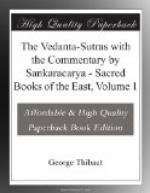the preceding ones whose task it is to lay down the
fundamental propositions regarding Brahman’s
nature.—The remaining adhikara/n/as of
the first pada follow the order of passages in the
Chandogya Upanishad, and therefore call for no remark;
with the exception of the last adhikara/n/a, which
refers to a Kaushitaki passage, for whose being introduced
in this place I am not able to account.—The
first adhikara/n/a of the second pada returns to the
Chandogya Upanishad. The second one treats of
a passage in the Ka/th/a Upanishad where a being is
referred to which eats everything. The reason
why that passage is introduced in this place seems
to be correctly assigned in the Sri-bhashya,
which remarks that, as in the preceding Sutra it had
been argued that the highest Self is not an enjoyer,
a doubt arises whether by that being which eats everything
the highest Self can be meant[10]—The third
adhikara/n/a again, whose topic is the ‘two
entered into the cave’ (Ka/th/a Up. I, 3,
1), appears, as Ramanuja remarks, to come in at this
place owing to the preceding adhikara/n/a; for if
it could not be proved that one of the two is the highest
Self, a doubt would attach to the explanation given
above of the ‘eater’ since the ‘two
entered into the cave,’ and the ‘eater’
stand under the same prakara/n/a, and must therefore
be held to refer to the same matter.—The
fourth adhikara/n/a is again occupied with a Chandogya
passage.—The fifth adhikara/n/a, whose topic
is the Ruler within (antaryamin), manifestly owes
its place, as remarked by Ramanuja also, to the fact
that the Vedic passage treated had been employed in
the preceding adhikara/n/a (I, 2, 14) for the purpose
of strengthening the argument [11].—The
sixth adhikara/n/a, again, which discusses ’that
which is not seen’ (adre/s/ya; Mu/nd/. Up.
I, 1, 6), is clearly introduced in this place because
in the preceding adhikara/n/a it had been said that
ad/ri/sh/t/a, &c. denote the highest Self;—The
reasons to which the last adhikara/n/a of the second
pada and the first and third adhikara/n/as of the
third pada owe their places are not apparent (the
second adhikara/n/a of the third pada treats of a Chandogya
passage). The introduction, on the other hand,
of the passage from the Pra/s/na Upanishad treating
of the akshara. O/m/kara is clearly due to the
circumstance that an akshara, of a different nature,
had been discussed in the preceding adhikara/n/a.—The
fifth and sixth adhikara/n/as investigate Chandogya
passages.—The two next Sutras (22, 23)
are, as remarked above, considered by Sa@nkara
to constitute a new adhikara/n/a treating of the ‘being
after which everything shines’ (Mu/nd/.
Up. II, 2, 10); while Ramanuja looks on them as
continuing the sixth adhikara/n/a. There is one
circumstance which renders it at any rate probable
that Ramanuja, and not Sa@nkara, here hits the
intention of the author of the Sutras. The general
rule in the first three padas is that, wherever a
new Vedic passage is meant to be introduced, the subject




